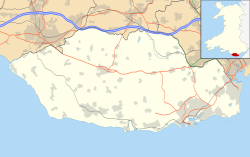Architecture
The 14th century, [11] red-tiled church is a substantial structure in the later English style, consisting of a nave, south aisle, and chancel, with a 16th-century embattled tower at the west end. The nave is 45 feet (14 m) long and 33 feet (10 m) broad including the aisle. The chancel 22 feet (6.7 m) long and 15 feet (4.6 m) wide and the arch dates further back to the twelfth century, evidently from the earlier building which was situated on the site. [12] [13] The eastern window of the south aisle is elegantly design, and that of the chancel is ornamented with stained glass, representing the arms of the Traherne family. The Bassett Family Tomb Enclosure is listed as a Grade II building in its own right. [14] In the chancel is a recumbent figure, in armour, with a Latin inscription, to the memory of Thomas Bassett of Old Beau Pre, who died in 1423. In the south aisle, there is a tablet to the memory of the late Mrs. Traherne, who died in 1796, and to that of her sister, Anna Maria Edmondes. [12]
The church was restored in 1861–1862 "at the expense of Mrs Charlotte Traherne of Coedriglan" under the designs of the architect Sir George Gilbert Scott and Reverend John Montgomery Traherne. [13] A memorial plaque on the lych gate commemorates parishioners who died in World War I. [15]
This page is based on this
Wikipedia article Text is available under the
CC BY-SA 4.0 license; additional terms may apply.
Images, videos and audio are available under their respective licenses.

